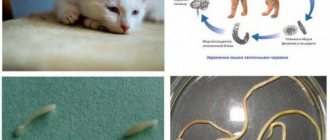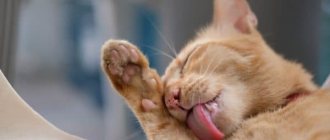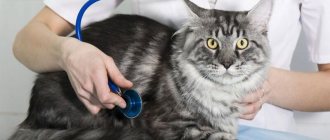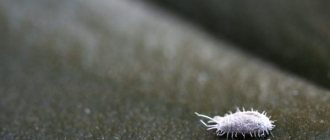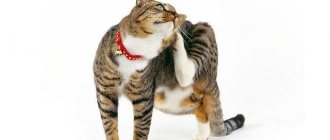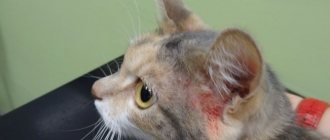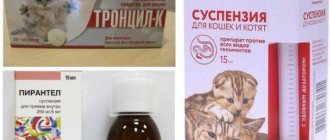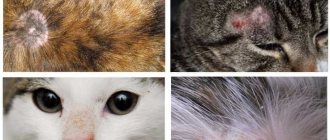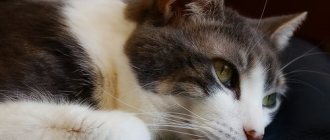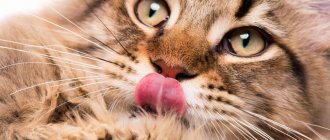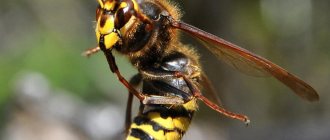When it comes to personal hygiene, cats are the epitome of cleanliness. They naturally have everything they need to groom themselves: a barbed tongue for licking, front paws that they moisten with saliva and use as a washcloth, and teeth for digging out harder debris. Believe it or not, adult cats can spend up to half of their waking hours grooming themselves, their family, and their friends.
Immediately after birth, mothers begin licking their kittens to clean them, stimulate urine and feces, encourage them to nurse, and provide comfort. Kittens usually begin grooming themselves when they are about 4 weeks old. At 5 weeks of age, kittens also begin to care for their littermates and their mother.
Normal or pathological?
Normal cat hygiene is licking all fur several times a day, and briefly washing after contact with other animals or people. At the same time, the cat behaves calmly and relaxed, she is focused on the cleanliness of her coat.
A disease should be suspected if any movement of the animal is accompanied by licking of fur. At the same time, the cat behaves restlessly, is irritated or feels discomfort. This behavior may indicate itching or pain that the animal is suffering.
If a cat constantly licks itself, the cause of this phenomenon is:
- Parasites;
- Allergic reaction;
- Lichen;
- Dermatitis;
- Endocrine disorders;
In this case, you can detect accompanying symptoms of diseases - scratching of the epidermis, the formation of erosions and wounds, peeling of the skin.
Diagnostic measures
Constant licking of fur is an alarming symptom, indicating that pathological processes are occurring in the animal’s body, often associated with mental instability and severe stress. Therefore, it is recommended to immediately take the cat to the veterinarian to identify the causes of this phenomenon and make an accurate diagnosis.
The veterinarian will conduct a visual examination of the animal and prescribe a number of laboratory tests. If dermatitis, fungal infection or infectious skin diseases are suspected, a bacteriological culture from the affected area is taken. If the doctor suspects that the cat has problems with the functioning of the endocrine system, it will be necessary to take a blood test for hormones.
Symptoms of the presence of parasites
Animals show increased attention to their own hygiene in the presence of parasites - fleas or ticks.
At the same time, the cat is constantly itching, shaking itself off and licking itself. You can suspect parasites by carefully examining the animal's fur. If no fleas are found, it is recommended to inspect the coat again, paying attention to the areas behind the ears and on the neck. A possible cause of discomfort may be nits, which can be difficult to detect with a quick examination. Excessive peeling of the skin in the absence of visible parasites may indicate a mite.
As a rule, with such diseases, the animal constantly tries to gnaw something out of the fur, simultaneously licking different parts of the body. Treatment is carried out using special anti-parasitic drops.
We recommend the article: What could cause a swelling of the lower lip in a cat?
Therapeutic measures
Constant licking of fur is not a separate disease, but a symptom of a certain pathology, so treatment is selected individually, depending on the diagnosis:
- If the cause of the symptom is diseases such as allergic reactions to food or hygiene products, local spectrum drugs are prescribed - ointments and creams that eliminate unpleasant symptoms, itching and burning. To prevent allergies from occurring again, you need to determine what exactly was the allergen, otherwise the discomfort will return again. In case of a severe allergic reaction, antihistamines are prescribed for internal use.
- Infections and inflammations on the skin of infectious origin require a course of antibiotics.
- If a fungus has been identified, antifungal medications are prescribed.
Also watch the video why cats lick themselves so often:
Ringworm and fungi
Ringworm in animals appears as small patches of baldness. In this case, scabs or erosion may be present on the skin, but this depends on the causative agent of the disease.
Quite often, the reason that an animal licks itself more often than usual is a fungal infection. It is impossible to identify the fungus without special equipment, but dry skin and flaking can help you suspect the disease. It is these symptoms that cause discomfort to the cat, in response to which he constantly licks himself, itches and chews his fur.
Upon careful examination, you will notice the following signs on the skin:
- Severe dryness;
- Change in color (pale skin or redness);
- Separation of dense grayish scales;
- Hair thinning;
These symptoms are characteristic of various fungal infections, including lichen. In this case, hair loss can be caused both by the characteristics of the disease and by the actions of the animal itself. Often, in response to itching, cats gnaw out islands of fur, trying to reach the skin with their claws.
Treatment of fungal infections is carried out with the help of antimycotic drugs. Shampoos and ointments used to treat people are usually prescribed - Nizoral, Ketoconazole, Clotrimazole.
If an unpleasant habit appeared after the castration procedure
The fact that an animal licks itself non-stop after sterilization is a normal, understandable phenomenon. After surgery, when the incision scar begins to heal, this process is accompanied by severe itching and burning. It is not surprising that the cat will try to relieve discomfort by constantly licking the skin.
But it is important for the owner to understand what this can lead to. If the suture is constantly wet after surgery, this will lead to poor and too slow healing and increase the risk of secondary infection.
To protect against negative consequences, the pet is recommended to wear a surgical collar for 10 days after castration, until the suture finally heals.
Allergies as a cause of unusual behavior
Food allergies always manifest themselves as crusts, wounds and erosions on the animal’s face. Sometimes cats develop allergic dermatitis in response to household irritants. Quite often, itching and flaking of the skin appear after:
- Applying a new shampoo while bathing the cat;
- Removing fleas with special solutions;
- Contact of household chemicals with animal fur;
The symptoms of an allergy are in many ways similar to the signs of a fungus on the skin - the cat constantly licks itself and itches. As a rule, the hypersensitivity reaction passes quickly, you just need to protect the animal from contact with the irritant.
Veterinarian advice
It is no secret that many parasites and viruses are transmitted from one animal to another, through the hands of people, but you should not be afraid and limit the freedom of a cat. Of course, there is no need to throw your pet into a pack of stray cats, but letting it out for a walk on the balcony or in the country is quite possible. Like any animal, cats also need fresh air and sun. It is enough just to keep the animal clean and carry out timely antiparasitic treatment.
Do not forget about a proper and balanced diet, which is also the key to your pet’s health. If he has a strong immune system, then no infection will be scary to him. Do not feed prohibited foods, sweets, salty and smoked foods. All this can cause or provoke the occurrence of food allergies. Pay attention to when your pet licks.
And finally, the last piece of advice is love and affection. Remember that your cat is a living creature that needs your care and attention. A change of owner or a change in your behavior can cause stress in your pet. And stress, as you know, is the first step to illness. If you want to pet an animal, but it is nervous and wags its tail, it is better to leave it alone, do not squeeze or pick it up without the desire of the pet itself. Remember that he also has the right to peace and rest.
Sorry, there are no surveys available at this time.
Dermatitis in cats
Itching and pain of the skin can be caused by dermatitis.
This disease is caused by an immune disorder and the activation of opportunistic microorganisms on the animal's skin. Dermatitis is always accompanied by inflammation of the epidermis. With moderate inflammation, the animal becomes restless, itching, and the cat constantly licks its fur. Suspecting the disease at this stage is quite problematic.
We recommend the article: Why does a cat limp on its front leg?
In most cases, dermatitis is accompanied by visible symptoms - severe peeling of the skin, the formation of rashes, wounds and erosions. The rashes are most often localized on the pet's face, near the ears and on the neck.
Treatment is carried out using external agents, but only after identifying the pathogen.
Video “Cats also love to swim”
Do you think cats don't like to bathe? They love it so much! This video is proof of our words. Moreover, timely and proper bathing will help your pet not only be clean, but also protect it from itching and fleas.
Was this article helpful?
Thank you for your opinion!
The article was useful. Please share the information with your friends.
Yes (81.82%)
No (18.18%)
X
Please write what is wrong and leave recommendations on the article
Cancel reply
Rate the usefulness of the article: Rate the author ( 20 votes, average: 4.45 out of 5)
Discuss the article:
Prevention means
Only a specialist can cure dangerous licking of a cat’s fur. To protect your pet from overgrooming, you should follow some simple rules for keeping cats:
- try to avoid stressful situations in your pet’s life, and if they arise, use homeopathic sedatives;
- carry out antiparasitic prevention in a timely manner;
- create the right diet and follow it;
- Monitor your pet's health and prevent illness.
Problems not related to diseases
In some cases, excessive licking is not caused by any health problems.
This can be caused by various reasons, the most common of which are
- Stressful situations cause nervous tension, but in this case the cat’s behavior also changes. Her tail quivers, she shakes constantly, and her pupils are greatly dilated. Such conditions can occur during movement, with a sudden change in environment, or with aggressive behavior of other animals or owners.
- The desire to get rid of foreign odors, which most often manifests itself when a cat is stroked by a stranger or after returning from a walk in the fresh air.
- Fear of closed spaces, which may seem strange, but staying indoors for a long time has a negative effect on the cat’s psyche. In this position, he can lick himself to the point where serious wounds occur.
- Active grooming in the tail area when the female is in estrus, which is an attempt to clean the tail.
All pathological conditions should always be under observation, and the animal should not be deprived of attention.
Frequent and prolonged licking quickly leads to habituation, called excessive grooming. This is a mental disorder that is most common among purebred cats, but is also common in regular pets.
Dangerous complications
Excessive grooming is a fairly serious deviation that can lead to negative consequences. Lack of timely and proper care can lead to:
- The formation of wool plugs in the cat's stomach and intestines, which leads to obstruction and accumulation of feces.
- The formation of non-healing wounds, ulcers or scratches, which are open gates for various infections. In severe cases, this can lead to the formation of necrotic lesions. To prevent this, wounds should be treated with antiseptic sprays and ointments and covered with bandages and plasters.
- The natural growth of the coat is disrupted and its protective functions deteriorate.
Excessive grooming is a pathology that requires a special approach and great responsibility. If it is caused by physiological health problems, treatment should be aimed at eliminating them. After recovery from the underlying disease, pathological licking will go away spontaneously.
Psychological problems will require more attention. Don't limit their freedom, play for at least 15-20 minutes a day, pet them regularly and show them love.
When moving, take familiar things with you, such as a cat house, scratching post or bed. In severe cases, veterinarians may prescribe medications to normalize the cat's condition.
Maintaining hygiene
A pet needs some regular care. This is especially true for cats that roam freely on the street. The animals themselves also monitor the cleanliness of their bodies, and carry out all cleaning procedures independently. For this reason, cats constantly lick themselves.
Most often, furry pets take care of themselves after eating, sleeping, or visiting the litter box. The tongue of cats is designed in such a way that it is able to clean off matted fur, food debris, dirt, and dead hairs.
In addition to cleansing, licking helps to distribute sebaceous secretions evenly throughout the body. The fat secreted by the animal's skin is necessary to lubricate the coat, which also contributes to its elasticity.
A clean animal carefully licks its fur, washes its face and ears with its paws, and removes unnecessary hair between its claws with its teeth. If your pet has thick fur, it is recommended to inspect it periodically. Sometimes tangles form in hard-to-reach places. For this reason, you should periodically comb the animal with a special brush, and carefully cut off the tangles.
Licking allows you to lay the fur in the right direction - this is another reason why a cat constantly licks itself. In this way, the animals manage to maintain the required temperature regime.
Is overgrooming a sign of illness?
There are many conditions that lead to excessive licking, often due to the resulting itching or soreness of the skin. Probably the most common cause is hypersensitivity to flea bites. Skin irritation in cats can also be the result of a reaction to substances in their diet or environment.
Lower urinary tract disease is a common problem in cats and can cause pain and discomfort in the bladder and other parts of the urinary tract. Cats, in response to pain, may resort to overgrooming in areas localized to the point of pain - usually baldness (or sparse hair) is observed on the lower abdomen, inner thighs and around the genitals.
Another reason for the development of overgrooming is also Feline Hyperesthesia Syndrome (or idiopathic syndrome). It is a poorly understood condition that manifests itself in strange behavior such as skin twitching, sudden bouts of intense grooming, and even biting itself, usually on the hind legs and tail.
In addition to those listed, there are many other reasons that may require special analyzes and tests to determine.
If you notice that your cat is constantly itching, licking itself, and at the same time acting restlessly, hitting its tail, you should immediately take your pet to the veterinarian. It is better not to try to establish the cause and diagnosis yourself, since many of the symptoms are similar to each other. Laboratory analysis and proper examination will be required.
If the reason that the cat is constantly itching, licking and licking itself lies in fleas and other skin and fur parasites, then external treatment is prescribed. The veterinarian may prescribe special drops or sprays, or recommend treating the animal with medicated shampoo. As a rule, using all these drugs several times helps to quickly remove itching and irritation and overcome parasites. In the future, only timely prevention will be required.
If the skin ailment is caused by an infection or fungus, medicinal sprays and drops will also help in the early stages. But, as practice shows, special medications and antibiotics may still be required. If the cat is constantly itching, licking its face, scratching its ears and eyes, antihistamines are prescribed. An accurate analysis is performed and the source of the allergy is determined.
What to do if a cat licks itself until it has bald patches and wounds?
The most reasonable solution in this situation is to show your four-legged pet to a veterinarian. An attempt to help a pet on your own is fraught with serious consequences for its health, since it is impossible to determine at home what exactly led to such unusual behavior of the animal.
The veterinarian will prescribe an examination for the four-legged patient and identify the cause of persistent licking, accompanied by exposure of the skin and the appearance of wounds on it. If parasites are the culprit of the cat’s behavior, she will be prescribed antiparasitic veterinary medications. If it turns out that the source of the problem is a malfunction of any internal organ, the cat will be prescribed appropriate treatment.
It is not always necessary to treat a pet that licks its skin to bald spots. Sometimes it’s enough to simply calm him down by creating a calm atmosphere in the house, or give him a bath if he thinks his fur smells of something unpleasant. In the latter case, you need to use zoo shampoos - they do not contain fragrances.
The desire to cleanse itself as a reaction to foreign odors on the fur
Cats are very clean creatures. In addition, they have an excellent sense of smell, thanks to which they are able to sense even subtle odors. If the pet feels that its fur smells of something, it will begin to lick it until it completely gets rid of it. Sometimes this desire leads to bald spots appearing on the body of an animal that washes itself too zealously.
